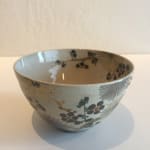


Eiraku Kiln
Tea Bowl, early 1900s
3" X 4 3/4"
Further images
This stunning bowl is one of the pinnacles of Eiraku ware. The rich legacy of the Zengorō family, known as the Eiraku family, is deeply rooted in pottery. The lineage...
This stunning bowl is one of the pinnacles of Eiraku ware.
The rich legacy of the Zengorō family, known as the Eiraku family, is deeply rooted in pottery. The lineage began with the first Zengorō, who crafted Doburo (clay braziers) for Sakai's Tea master, Takeno Jōō, earning the title Doburo Zengorō. The second-generation Zengorō lived in Sakai, while the third generation and beyond established themselves in Kyoto, making Doburo and Tea bowls. Under esteemed Kobori Enshū's orders, the family received a copper seal with "Zengorō," a mark used until the ninth generation.
In 1788, a major fire destroyed their residence and seal, but the Eiraku family, led by the tenth-generation Ryōzen, rebuilt with support from the prestigious tea practitioners.
In 1827, the eleventh-generation Zengorō Hōzen was honored with an invitation to the kiln opening at Nishihama-goten by Tokugawa Harutoshi, the tenth Kishū Daimyo lord. In a gesture of profound gratitude, he was presented with a silver seal inscribed with the name 'Eiraku.' This marked a significant transition in the family's history, as from the twelfth generation, Kazen, the family officially adopted the Eiraku surname.
The rich legacy of the Zengorō family, known as the Eiraku family, is deeply rooted in pottery. The lineage began with the first Zengorō, who crafted Doburo (clay braziers) for Sakai's Tea master, Takeno Jōō, earning the title Doburo Zengorō. The second-generation Zengorō lived in Sakai, while the third generation and beyond established themselves in Kyoto, making Doburo and Tea bowls. Under esteemed Kobori Enshū's orders, the family received a copper seal with "Zengorō," a mark used until the ninth generation.
In 1788, a major fire destroyed their residence and seal, but the Eiraku family, led by the tenth-generation Ryōzen, rebuilt with support from the prestigious tea practitioners.
In 1827, the eleventh-generation Zengorō Hōzen was honored with an invitation to the kiln opening at Nishihama-goten by Tokugawa Harutoshi, the tenth Kishū Daimyo lord. In a gesture of profound gratitude, he was presented with a silver seal inscribed with the name 'Eiraku.' This marked a significant transition in the family's history, as from the twelfth generation, Kazen, the family officially adopted the Eiraku surname.
Signup for our Newsletter
You will receive two emails a month from us. One introduces artworks and design works from Kyoto's hidden sources and the other is stories from Misako, sharing insights into Japanese culture.
* denotes required fields
为了回应您的查询,我们将根据我们的隐私政策处理您提供的个人数据。


